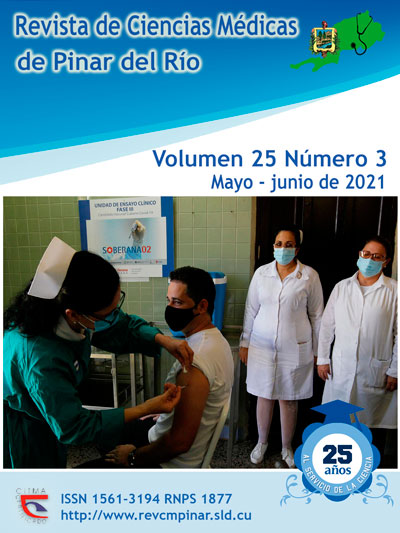Early diagnosis of asymptomatic aortic abdominal aneurysm in Pinar del Rio
Keywords:
AORTIC ANEURYSM, ABDOMINAL, EARLY DIAGNOSIS, RISK FACTORS, AORTA, DILATATION, ULTRASONOGRAPHY, DOPPLER.Abstract
Introduction: aortic abdominal aneurysm constitutes an entity with a high mortality rate in current times.
Objective: to characterize the patients with the diagnosis of aortic abdominal aneurysm in Pinar del Rio province.
Methods: a descriptive, prospective-longitudinal study was conducted with patients having aortic abdominal aneurysms treated in Angiology Service during the period 2013-2017. The target group comprised 70 patients who came for an abdominal ultrasound, they were diagnosed as aortic abdominal aneurysm carriers, and all of them were studied.
Results: patients identified by Imaging Department reached the 58,56 %; male sex predominated (95,7 %), as risk factors prevailed smokers (90 %) and hypertensive patients (85,7 %). Aneurysmal sac growth was observed in relation to hypertension; and there was no increase in diameter in 44,3 % of patients; 7,15 % of the patients underwent surgery, 100 % were patients with an initial diameter greater than 5 cm.
Conclusions: aortic abdominal aneurysms were common in male patients past the fourth decade of life, occurring mainly in smokers and hypertensive patients. Radiology department was the main source of referral. Early identification and timely treatment are determinant elements for a positive outcome of this disease.
Downloads
References
1. Granja Gomes GR, Cordeiro D’Ornellas M, Nogara Dotto G. Direct and virtual measurements of abdominal aortic aneurysms: three-dimensional printed models. Radiol Bras [Internet]. 2021 Jan/Feb [citado 26/02/2021]; 54(1). Disponible en: https://www.scielo.br/j/rb/a/DGTYr53J9tsLspp3PZqx54R/?lang=en
2. Reijnen MM, Holden A. Status of endovascular aneurysm sealing after 5 years of commercial use. Journal of Endovascular Therapy. [Internet]. 2018 [citado 20/02/2021]; 25(2):201-206. https://europepmc.org/article/med/29380655
3. Carpenter JP, Lane JS, et al. Refinement of anatomic indications for the Nellix System for endovascular aneurysm sealing based on 2-year outcomes from the EVAS FORWARD IDE trial. Journal of Vascular Surgery. [Internet]. 2018[citado 20/02/2021]; 68(3): 720-30 https://www.sciencedirect.com/science/article/pii/S0741521418302830
4. Chaikof EL, Dalman RL, Eskandari MK, et al. The Society for Vascular Surgery practice guidelines on the care of patients with an abdominal aortic aneurysm. J Vasc Surg[Internet]. 2018 [citado 20/02/2021]; 67(1): 2-77.e2 https://www.sciencedirect.com/science/article/pii/S0741521417323698?via%3Dihub
5. Deery SE, O'Donnell TFX , Pothof AB, et al. Declining Mortality Rates from Abdominal Aortic Aneurysms Across All Age, Sex, and Racial Groups. J Vasc Surg[Internet]. 2017[citado 20/02/2021]; 66(2): e7. https://www.jvascsurg.org/article/S0741-5214(17)31325-3/fulltext
6.Molacek J. Editorial commentary: Abdominal aortic aneurysm - Size still matters. Trends Cardiovasc Med [Internet]. 2020 Nov [citado 26/02/2021]; 30(8): 505-6. Disponible en: https://pubmed.ncbi.nlm.nih.gov/31883861/
7. Coronel J, Palacio J, Rueda Esteban R. Multiple Software Based 3D Modeling Protocol for Printing Anatomical Structures. International Journal of Morphology [Internet]. 2017 Jun [citado 26/10/2021]; 35(2): 425 – 29. Disponible en: http://www.scielo.cl/scielo.php?script=sci_arttext&pid=S0717-95022017000200006&lng=pt&tlng=en.
8. Kasashima S, Zen Y, Kawashima A, Endo M, Matsumoto Y, Kasashima F. A new clinicopathological entity of IgG4-related inflammatory abdominal aortic aneurysm. J Vasc Surg. [Internet]. 2009 [citado 20/10/2021]; 49(5): 1264-71. https://www.sciencedirect.com/science/article/pii/S0741521408020119
9. Haimovici H. Cirugía vascular. España: Editorial Salvat en Martos López J. Patología aórtica aguda. 1988 España: Hospital San Cecilio.
10. Karthikesalingam A, Holt PJ, Vidal-Diez A, et al. Mortality from ruptured abdominal aortic aneurysms:clinical lessons from a comparison of outcomes in England and the USA. Lancet [Internet]. 2014[citado 20/10/2021]; 383(9921): 963-9. https://pubmed.ncbi.nlm.nih.gov/24629298/
11. Durán Llobera CS. Aneurismas arteriales. En: Pardo Gómez G. Temas de cirugía. T-2. La Habana: ECIMED [Internet]. 2010 [citado 20 oct 2017]. Disponible en: http://www.bvs.sld.cu/libros_texto/temas_cirugia2/temas_cirugia2_completo.pdf
12. Clavijo Rodríguez T, Valencia Díaz E, Barnés Domínguez JA, Carballo tores Ortega Rodríguez O, Guevara Alfayate L. Aspectos clínicos y epidemiológicos de los aneurismas de la aorta abdominal. Rev Cubana Angiol y Cir Vasc [Internet]. 2014 [citado 20/10/2021]; 15(1):22-29. Disponible en: http://scielo.sld.cu/scielo.php?script=sci_arttext&pid=S1682-00372014000100004&lng=es&nrm=iso&tlng=es
13. Tarazona MM, Camacho J, Peláez M, Carreño M, Sandoval N, Umaña JP. Resultados del tratamiento quirúrgico de los aneurismas de aorta abdominal infrarrenal. Rev. Colomb. Cardiol [Internet]. 2015 Jan [citado 26/10/2021]; 22(1): 54 – 61. Disponible en: http://www.scielo.org.co/scielo.php?script=sci_arttext&pid=S0120-56332015000100010&lng=pt&tlng=es
14. Blanco Cañibano E, Morata Barrado PC, Muela Méndez M, García Fresnillo B, Guerra Requena M. Prevalencia de aneurismas de aorta abdominal en una población de riesgo en una consulta de cirugía vascular. Angiol (Barcelona) [Internet]. 2020 Mayo-Jun [citado 26/02/2026]; 72(3): 118-25. Disponible en: https://scielo.isciii.es/scielo.php?script=sci_arttext&pid=S0003-31702020000300002
15. Beltrán LM, Rodilla E. Ecografía clínica en el riesgo cardiovascular. Rev Clín Esp [Internet]. 2020 Ago-Sept [citado 26/02/2026]; 220(6): 364-73. Disponible en: https://www.sciencedirect.com/science/article/abs/pii/S0014256520300369
Downloads
Published
How to Cite
Issue
Section
License
Authors who have publications with this journal agree to the following terms: Authors will retain their copyrights and grant the journal the right of first publication of their work, which will be publication of their work, which will be simultaneously subject to the Creative Commons Attribution License (CC-BY-NC 4.0) that allows third parties to share the work as long as its author and first publication in this journal are indicated.
Authors may adopt other non-exclusive license agreements for distribution of the published version of the work (e.g.: deposit it in an institutional telematic archive or publish it in a volume). Likewise, and according to the recommendations of the Medical Sciences Editorial (ECIMED), authors must declare in each article their contribution according to the CRediT taxonomy (contributor roles). This taxonomy includes 14 roles, which can be used to represent the tasks typically performed by contributors in scientific academic production. It should be consulted in monograph) whenever initial publication in this journal is indicated. Authors are allowed and encouraged to disseminate their work through the Internet (e.g., in institutional telematic archives or on their web page) before and during the submission process, which may produce interesting exchanges and increase citations of the published work. (See The effect of open access). https://casrai.org/credit/



